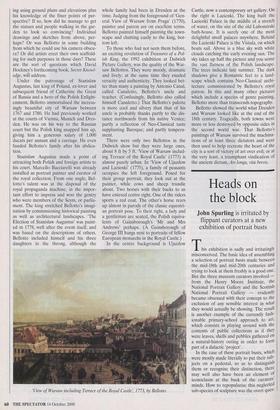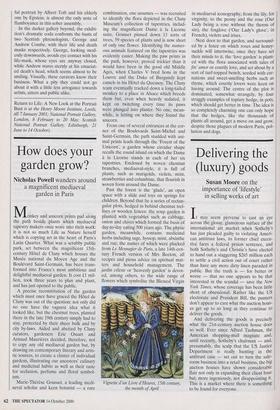Heads on the block
John Spurling is irritated by flippant curators at a new exhibition of portrait busts
This exhibition is sadly and irritatingly misconceived. The basic idea of assembling a selection of portrait busts made between the mid-18th and mid-20th centuries and trying to look at them freshly is a good one. But the three museum curators involved — from the Henry Moore Institute, the National Portrait Gallery and the Scottish National Portrait Gallery — evidently became obsessed with their concept to the exclusion of any sensible interest in what they would actually be showing. The result is another example of the currently fash- ionable primary-school approach to art, which consists in playing around with the contents of public collections as if they were leaves, shells and pebbles gathered on a natural-history outing in order to form part of a didactic 'project'. In the case of these portrait busts, which were mostly made literally to put their sub- jects on a pedestal, so as to distinguish them or recognise their distinction, there may well also have been an element of iconoclasm at the back of the curators, minds. How to repopularise this neglected sub-species of sculpture was the overt ques-
tion. But the subliminal one was perhaps how to reduce all these marble and bronze eminences to anonymous people. Just so, the Committee of Public Safety in revolu- tionary Paris might have mounted an exhi- bition of real heads brought in by the basketful and treated them as random examples of human features and bone- structure without particularising the lives they led before being cut off.
Here, the busts are presented in two main groups: the first as ensembles of head, shoulders and pedestal; the second as faces and their features. Thus, in the first group, Joseph Nollekens's 'Charles James Fox' is 'a good example of the male torso becoming the sculptural support, in the strange marriage of body and base', while in Epstein's 'George Black', 'folded arms provide an unusually substantial base for the form'. Fox, the great orator and reformer who favoured the French Revolu- tion and championed civil liberties — and who looks, in this heavy Roman Republic- style portrait, as dissolute as he really was
is no doubt famous enough to brush off a liberty of this sort. But one has to consult the 'archive' hidden away under the exhibi- tion's reception desk in order to discover that George Black — also apparently 'a controversial, opinionated and sometimes self-indulgent man' — was an ophthalmic surgeon and pioneer of cornea-grafting. So Epstein did not gouge deep holes to repre- John Adams Acton's 'Henry Peter Brougham' and Sir Francis Chantrey's 'John Rennie' sent the pupils in Black's eyes just in order to give him a gimlet stare. The folded arms are rather beside the point.
The artists are treated as churlishly as the sitters. In the second group, four mar- ble busts are brought together as examples of childhood, youth, maturity and old age. The boy and mature man are by Henry Weekes, the youth by Sir Francis Chantrey and the old man by Samuel Joseph. All are
carefully individualised portraits of particu- lar people and skilfully carved, though not necessarily by the sculptor himself, since at this date — early 19th century — following Nollekens's practice, it was often the assis- tants who turned their master's clay model into marble. On the other hand, since Weekes was Chantrey's assistant and took over his commissions as well as his studio after his death, it may have been he who carved Chantrey's portrait of Francis Homer, the politician and co-founder of the Edinburgh Review here pressed into the role of youth. Another of Samuel Joseph's impressive busts, meanwhile, that of Sir David Wilkie, is placed in the first group as an example of the use of drapery 'as a tran- sitional zone between head and socle'. None of these artists — not even Chantrey, except as the donor of the Chantrey Bequest — is now so well-known that their shades can be happy to be plucked like this from neglect only to illustrate a half-baked curatorial meditation on the four ages of man.
Nevertheless, if one can forget all these irritations, the busts are very well displayed in the Henry Moore Institute's high, bright gallery and, with people moving among them, emanate the calm and dignity which their sculptors mostly intended to give them. The eccentric, flame-like moustache sported by the author and politician Robert Cunninghame Graham, in both his youth- ful portrait by Albert Toft and his elderly one by Epstein, is almost the only note of flamboyance in this sober assembly.
In the darker gallery beyond, the exhibi- tion's dramatic coda confronts the busts of two Scottish phrenologists, George and Andrew Combe, with their life and death masks respectively. George, looking mod- estly downwards, avoids eye contact with his life-mask, whose eyes are anyway closed, while Andrew stares sternly at his emaciat- ed death's head, which seems almost to be smiling. Visually, these curators know their business. What a pity they could not go about it with a little less arrogance towards artists, sitters and public alike.
Return to Life: A New Look at the Portrait Bust is at the Henry Moore Institute, Leeds, till 7 January 2001; National Portrait Gallery, London, 8 February to 20 May; Scottish National Portrait Gallery, Edinburgh, 21 June to 14 October).




















































































 Previous page
Previous page